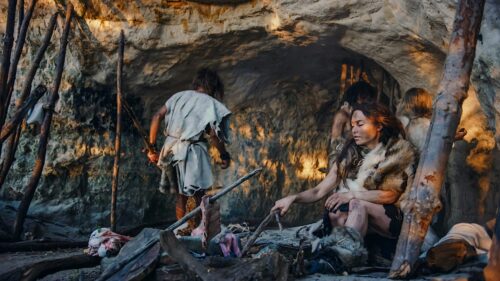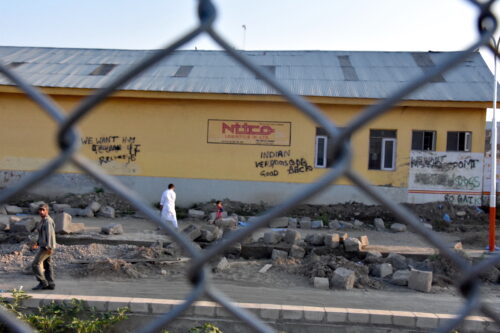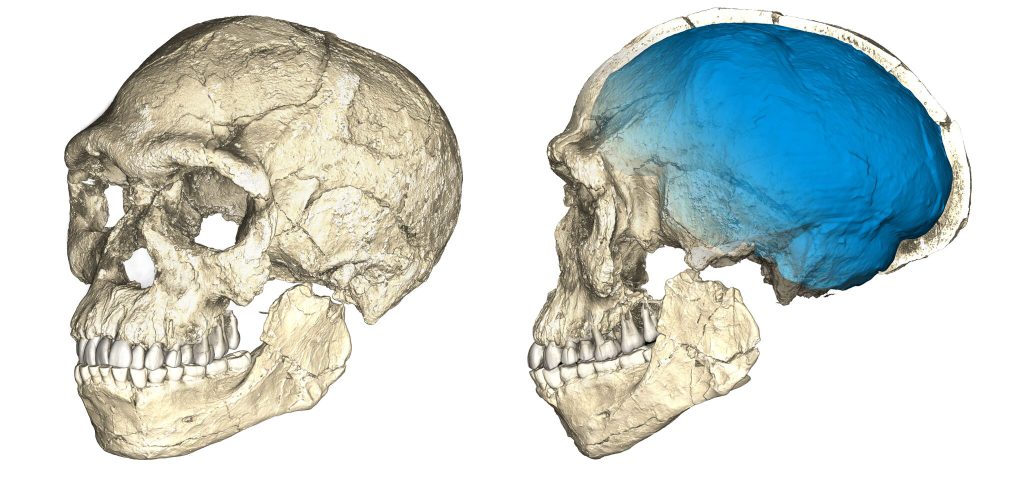Oldest-Known Homo Sapiens Fossils Found

Please note that this article includes an image of human remains.
The oldest bones yet of our species have been found, surprisingly, in an old Moroccan mine. At about 300,000 years old, the new collection of early Homo sapiens bones pushes back the first solid evidence of our species’ presence in Africa by 100,000 years.
The find reveals five individuals who were living in a cave, hunting animals like gazelles with stone-tipped spears. They were Homo sapiens, but they weren’t yet completely modern. “The face of these people is similar to faces you might cross in the street today,” says lead researcher Jean-Jacques Hublin of the Max Planck Institute for Evolutionary Anthropology in Leipzig, Germany. But their skulls show they had a more archaic, elongated brain than modern humans.
The Moroccan fossils add to a decades-long debate about how and where Homo sapiens arose. Until now, the firmest finds of early Homo sapiens were from two sites in Ethiopia, dating to around 200,000 years old. Those fossils put the spotlight on eastern sub-Saharan Africa for the origin of our species. But the new discovery is in northwestern Africa, more than 3,000 miles away.
The bones, along with Middle Stone Age tools found both at the Moroccan site and throughout Africa, support the view that Homo sapiens were living all around the continent at this early date; modern humans likely developed throughout this widely distributed population, Hublin argues. “Our emergence is probably not in some garden of Eden, but pan-African,” says Hublin. The team published their findings—describing the fossils and dating the site—today in Nature.
The Moroccan site, called Jebel Irhoud, tells a similar story as another early Homo sapiens site in Florisbad, South Africa, where a skull was dated to 260,000 years ago in the 1990s. That find also suggested an early origin for our species outside of East Africa. But it was a single, incomplete skull, notes Chris Stringer, an anthropologist at the Natural History Museum in London and an expert on human evolution. The new Moroccan site has a firmer date and holds 22 specimens from five different individuals, providing a much clearer view of this part of human evolution. “It really is an important find,” says Stringer.
The new fossils come from an old site: Miners stumbled on the first human remains at Jebel Irhoud in the 1960s. But dating the site was tricky. The first radiocarbon dates could only say fossils from the site must have been more than 40,000 years old; in 2006, a tooth from the site was dated to 160,000 years old. This date made the bones, with their combination of modern and archaic features, look like throwbacks rather than like early representatives of Homo sapiens. “They were thought to be an archaic pocket, while the real story [of human evolution] was emerging somewhere else,” says Hublin.
Starting in 2004, Hublin set out to get a better date for the site. For old fossils like these, researchers use dating techniques that rely on the fact that teeth and some stones, including flints, trap excited electrons created by natural radioactivity in the soils around them. Analyzing these trapped electrons can reveal the object’s age, as long as researchers know the background level of radiation. But the 1960s finds were gathered from a mess of rock and soil that had collapsed during mining, making it impossible to know where exactly the fossils came from or what radiation they had been exposed to.
Hublin’s team first had to clean up the mine, which meant removing about 200 cubic meters of limestone blocks and dirt with a bulldozer; they had to build a new road to get the heavy equipment to the mine. Clearing away debris revealed the back wall of an old cave, which they slowly chipped away at with chisels and hammers. Here they found a rich pocket of previously undiscovered remains in a small area about the size of Hublin’s desk: “Every 50 centimeters there is a human bone or a tooth or something,” Hublin says. All the human remains were in this very clear layer that was probably also the source of the earlier fossil finds in the mine.
The team also unearthed bones from gazelles, zebras, wildebeest, and lions that had been broken, cut, or burned by people living at the site, along with many burned flint tools.
When a flint is heated, the stone releases its trapped electrons, resetting its “clock.” By taking detailed measurements of background radiation in the excavated soils, and checking how many electrons the flints had trapped since last burned, the researchers could date the stone tools. Using this method, they dated about a dozen flints to an average age of more than 300,000 years old. “This was a big ‘wow,’” says Hublin. They also recalculated the age of the previously dated tooth as 286,000 years old.
No one knows how or when these early Homo sapiens arrived in what is now Morocco. The Saharan desert was green and wet around 330,000 years ago, which might have provided an opportunity for animals and people to travel into northern Africa, the researchers note. What happened later—when and how Homo sapiens got smarter and moved into what is now Europe—is also still under debate. “It’s very good and important work, but it doesn’t tell us much about modern human behavior,” notes Robert Franciscus, a paleontologist at the University of Iowa who worked on the Florisbad skull. “We still have a lot of work to do,” agrees Hublin.


































